Women love to change their image. But not everyone is ready for drastic changes. When doubts about dyeing hair in a different color outweigh the desire to try something new, colouration comes to the rescue. This is a special technique for dyeing strands in a few contrasting or close to natural color shades. In general, the procedure is relatively simple, so coloring hair at home can be performed with the same success as in a beauty salon.
Principle and features of coloring
Not knowing all the intricacies of modern hairdressing, many people confuse coloring and highlighting. Especially when strands are clarified in several different tones during melioration. In fact, the essence of melioration is exclusively in the clarification of strands, while coloring involves a full coloring of the hair.
In addition, it is impossible to beautifully mellow lightened hair or curls that have already undergone such treatment. For coloring, this is not a problem, as the painting is perfectly suited and blond, and melted curls.
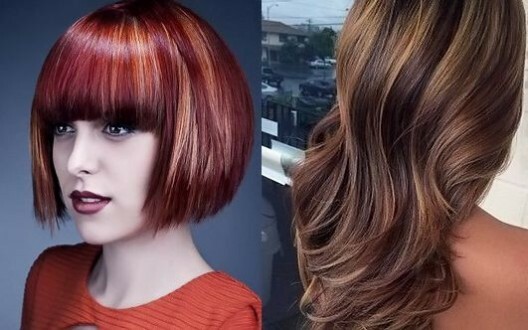
Coloring is partial and complete. In the first case, individual strands are to be colored. The natural color of the hair predominates, and the painted parts either contrast with it, or make up harmony. The shades of paint are chosen in advance so that the whole composition looks spectacular.
In the process of coloring hair in the technique of coloring, you can simultaneously use different types of dyes: persistent, tinting, brightening. The duration of the procedure depends on the chosen colors, the length, the initial color of the hair and the effect to be achieved.
Understanding what coloring hair, I want to know what advantages this staining technique has. Advantages of the technique are as follows:
- The natural color of the curls "comes to life", plays in different shades, overflows.
- Coloring on long hair allows to achieve a delightful effect in the form of a smooth transition of one color to another.
- Thin hair visually becomes more magnificent, more volume.
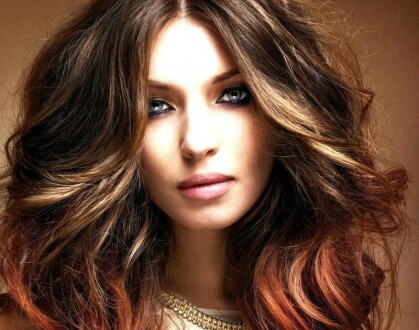
- Completely camouflaged with gray, so that outwardly the woman looks fresh and younger.
- The most simple hairstyles for short hair look fashionable and original.
- You can arrange bright accents in the right places of complex haircuts, making the image even more stylish.
- Depending on the order in which the colored strands are arranged, their shade varies with different lighting conditions.
Types and techniques of coloring
There are many options for coloring strands in different shades. But in general, the following types of coloring are distinguished: vertical and horizontal.
- With a vertical coloring method, 3 to 18 different color shades are used. The total mass of hair is divided into zones vertically and color each strand in the selected color. The distinctive features of this type of staining: contrasting color transitions, asymmetry, uneven shades.
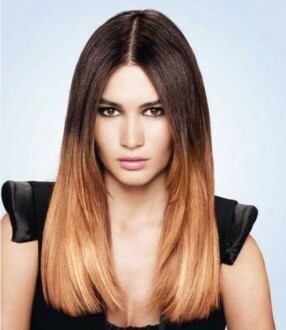 Horizontal coloring
Horizontal coloring 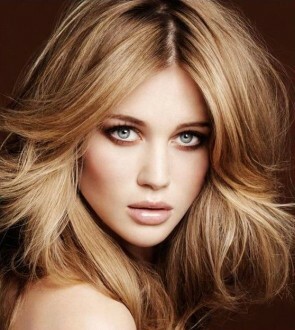 Vertical coloring
Vertical coloring
- Horizontal, or transverse, coloring is performed in a completely different way, and use for it no more than 3 shades. Hair is divided into zones horizontally: closer to the roots, middle, lower part. Each of them is divided into small strands. The upper part of the hair, close to the head, is painted in the darkest shade. The main, middle part of the curls are colored with a lighter color. The most light tone is used for coloring the ends of the hair.
As for coloring techniques, their varieties are much larger. The most popular are:
- Coloring is asymmetrical multicolor. Strands are randomly tinted in colors that are suitable for natural color or contrasting tones. The method is suitable for women and girls of all ages, with any color of hair.
- Coloring "salt with pepper" effectively falls on blond hair with graying. At the top, strands are lightened and painted in light colors. Falling down, make a gradual transition to a dark color.
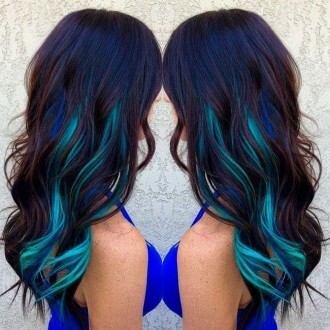
- Fashionable neon coloring is an ideal choice for young girls with dark hair. To color the strands use dyes of bright colors, which make the image creative. When performing neon coloring, the strands are first clarified and only then a special coloring gel is applied on them. Compositions in this case apply unstable, persisting on the hair for about a month.
- Coloring zonal involves painting the strands in a certain area.
- Coloring bangs - a technique whose name speaks for itself. Only the hair of the hair should be dyed with a forehead. The rest of the hair is not processed.
- The original technique of patterned coloring is also performed zonal. With the help of a special stencil on the selected part of the hairstyle, geometric patterns are created. Paints for patterns, as a rule, are selected only by bright, contrasting.
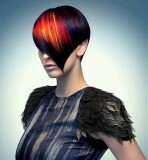 Coloring bangs
Coloring bangs  Ornamental coloring
Ornamental coloring
As for the popular technique of American coloring, the fair-haired ladies do not fit it. But the black hair looks amazing! Strands are painted in 4 different shades, combined with the original color of the curls. As a result, the overflow effect is obtained, as in the plumage of birds.
The owners of red hair for coloring are more relaxed, because their fiery hair is already attracting everyone's attention. If, however, the red-haired beauty decides to change the image a little by staining, the individual strands can only be lightened slightly or painted into copper, coffee, chocolate tones. For red hair, the technique of coloring is recommended to be chosen layer-by-layer, when colors consistently pass one into another.
How to color your hair yourself?
Before starting to work, you need to think about what kind, technique and coloring colors for coloring to choose, so that the result is pleased and, most importantly, was to face. Before painting, you should evaluate the condition of the hair, take into account the previous hairdressing manipulations to minimize the risk of damage.
We must not forget that the work is to be subtle and painstaking. Therefore, if there is no full confidence in their abilities, it is better not to do coloring at home, but to turn to the services of a professional. However, those who have little experience in dyeing hair at home can try to conduct the procedure themselves.
How to make coloring - video
First you need to buy a set of colors for coloring with the appropriate shades, carefully read the instructions and perform all actions strictly according to the instructions. Only in this case the result of the staining of the strands will be satisfactory.
Coloring stages
- 2-3 times before the procedure hair is shampooed with a clear cleansing effect. Until the moment of staining, no cosmetic means, varnishes, foams, gels for styling can be used.
- In order to avoid an allergic reaction, a small test should be performed before staining, applying the selected dye compositions to the inner fold of the elbow. If the skin reacts normally, you can proceed with coloring.
- On the shoulders should be thrown an old towel, which will protect clothing from getting corrosive paint.
- Skin on the line of hair growth on the forehead and temples is smeared with cream, petroleum jelly or any other fatty compound, so that the paint is not absorbed by stains in the epidermis.
- Dyes are spread in plastic bowls immediately before application to the strands. Cooking coloring compositions should be strictly according to the instructions. Stir very carefully so that not a single lump remains. In order not to get confused, you need to mark in what capacity which paint is located.
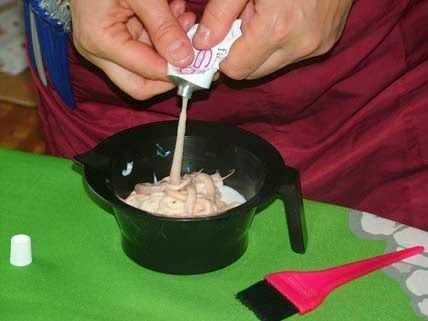
- Brush for each dye should be its own. If you have to use one brush, after using each kind of paint, you need to thoroughly wash and dry it.
- Depending on the type and coloring technique chosen, the total weight of the hair is divided into individual zones and subsequently stained with thin strands, placing pieces of foil under them. You need to work quickly, otherwise the staining will be uneven.
- If staining starts from the bang, move in the direction to the back of the head. If coloring is done from the occipital part, you need to move to the forehead. Strands that will not be color-coded, need to be removed to the side and stabbed, so that they do not interfere with the work.
- After applying the paint, the foil is wrapped and fixed on the head. Keep the coloring composition on strands for exactly as long as indicated in the instructions or on the packaging.
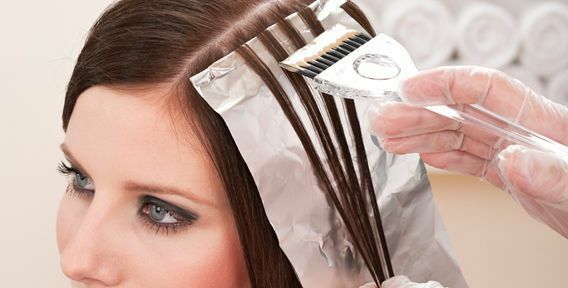
- The strands are then released from the foil and the paint is rinsed with water and shampoo. On still damp hair apply restoring balm. The skin on the forehead, temples, behind the ears is treated with tonic or cosmetic milk.
- The dried hair can be dried out with a hair dryer, but it's best to let them do this in the air naturally.
That's all. You can turn to the mirror and evaluate the result!
Related Videos:
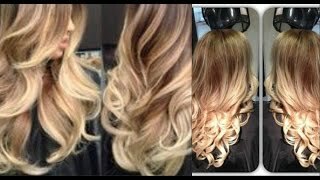 6:03
6:03 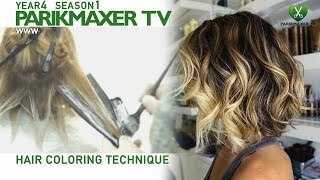 7:02
7:02 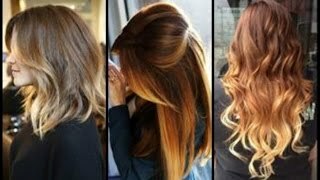 4:34
4:34 